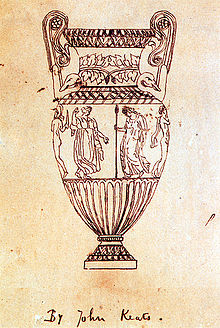
The "Ode on Indolence" is one of five odes composed by English poet John Keats in the spring of 1819. The others were "Ode on a Grecian Urn", "Ode on Melancholy", "Ode to a Nightingale" and "Ode to Psyche". The poem describes the state of indolence, a word which is synonymous with "avoidance" or "laziness". The work was written during a time when Keats was presumably more than usually occupied with his material prospects. After finishing the spring poems, Keats wrote in June 1819 that its composition brought him more pleasure than anything else he had written that year.[1] Unlike the other odes he wrote that year, "Ode on Indolence" was not published until 1848, 27 years after his death.
The poem is an example of Keats's break from the structure of the classical form. It follows the poet's contemplation of a morning spent in idleness. Three figures are presented—Ambition, Love and Poesy—dressed in "placid sandals" and "white robes". The narrator examines each using a series of questions and statements on life and art. The poem concludes with the narrator giving up on having all three of the figures as part of his life. Some critics regard "Ode on Indolence" as inferior to the other four 1819 odes. Others suggest that the poem exemplifies a continuity of themes and imagery characteristic of his more widely read works, and provides valuable biographical insight into his poetic career.
- ^ Gorell 1948 p. 78.